Jackson M.J. Micro and Nanomanufacturing
Подождите немного. Документ загружается.

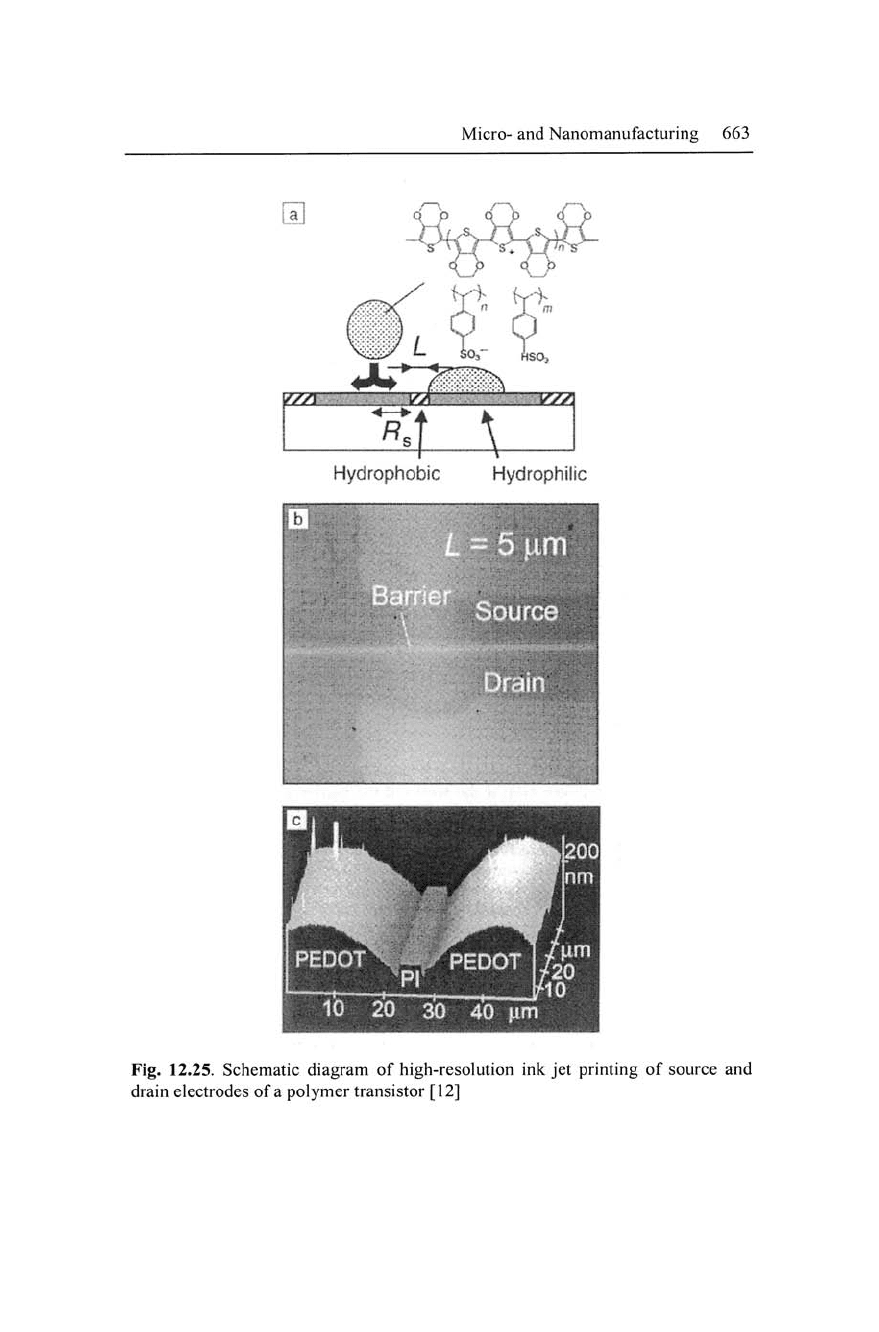
Micro- and Nanomanufacturing 663
CP O
-•—<-
zzzn
II
Dzza
s]_a
Hydrophobic Hydrophilic
Fig. 12.25. Schematic diagram of high-resolution ink jet printing of source and
drain electrodes of
a
polymer transistor [12]
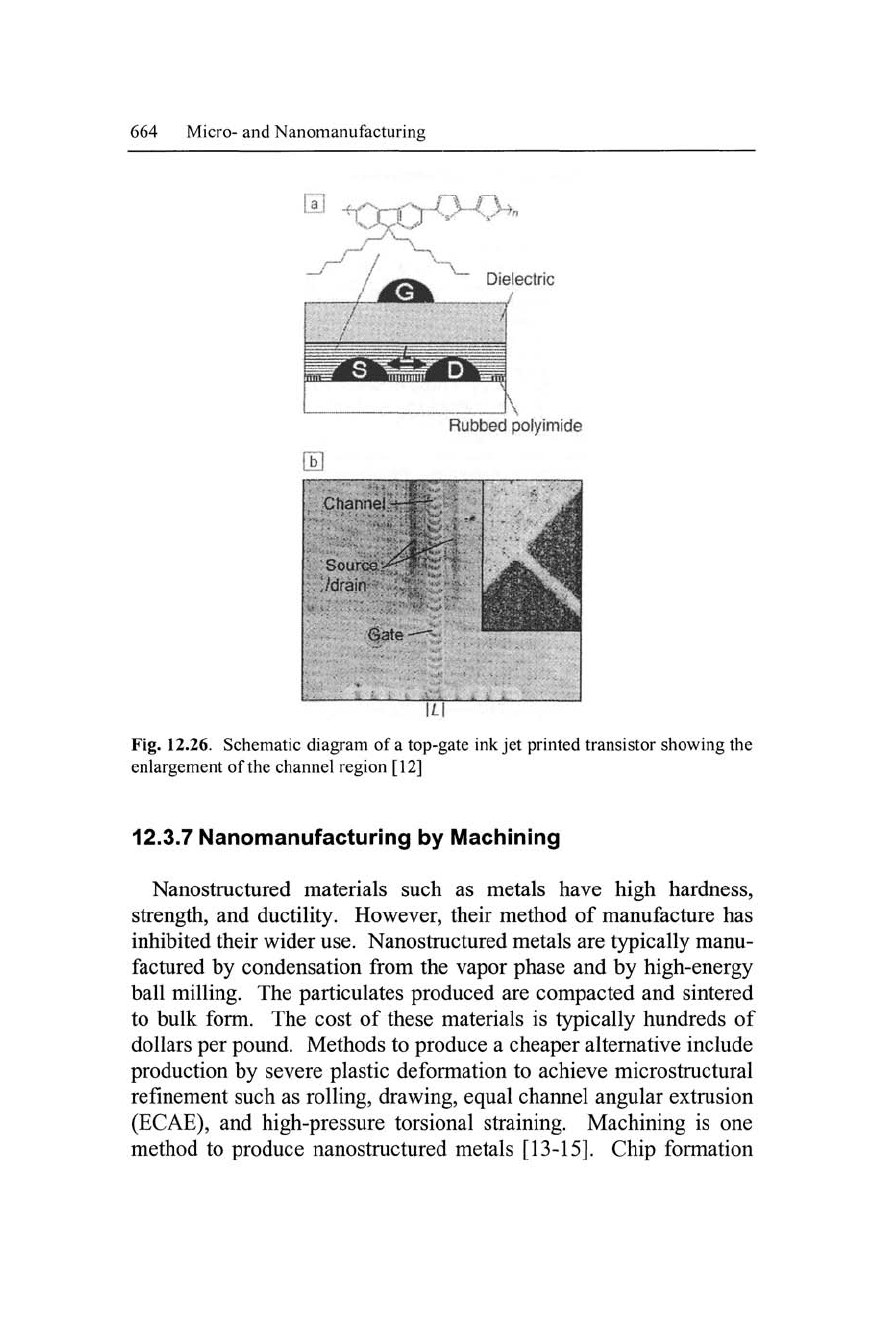
664 Micro- and Nanomanufacturing
XXX^'^^'^
Dielectric
Rubbed poiyimide
rbi
CUsnnei'^^-jxf:-'
\i\
Fig. 12.26. Schematic diagram of a top-gate ink jet printed transistor showing the
enlargement of the channel region [12]
12.3.7 Nanomanufacturing by Machining
Nanostructured materials such as metals have high hardness,
strength, and ductility. However, their method of manufacture has
inhibited their wider use. Nanostructured metals are typically manu-
factured by condensation from the vapor phase and by high-energy
ball milling. The particulates produced are compacted and sintered
to bulk form. The cost of these materials is typically hundreds of
dollars per pound. Methods to produce a cheaper alternative include
production by severe plastic deformation to achieve microstructural
refinement such as rolling, drawing, equal channel angular extrusion
(ECAE), and high-pressure torsional straining. Machining is one
method to produce nanostructured metals [13-15]. Chip formation
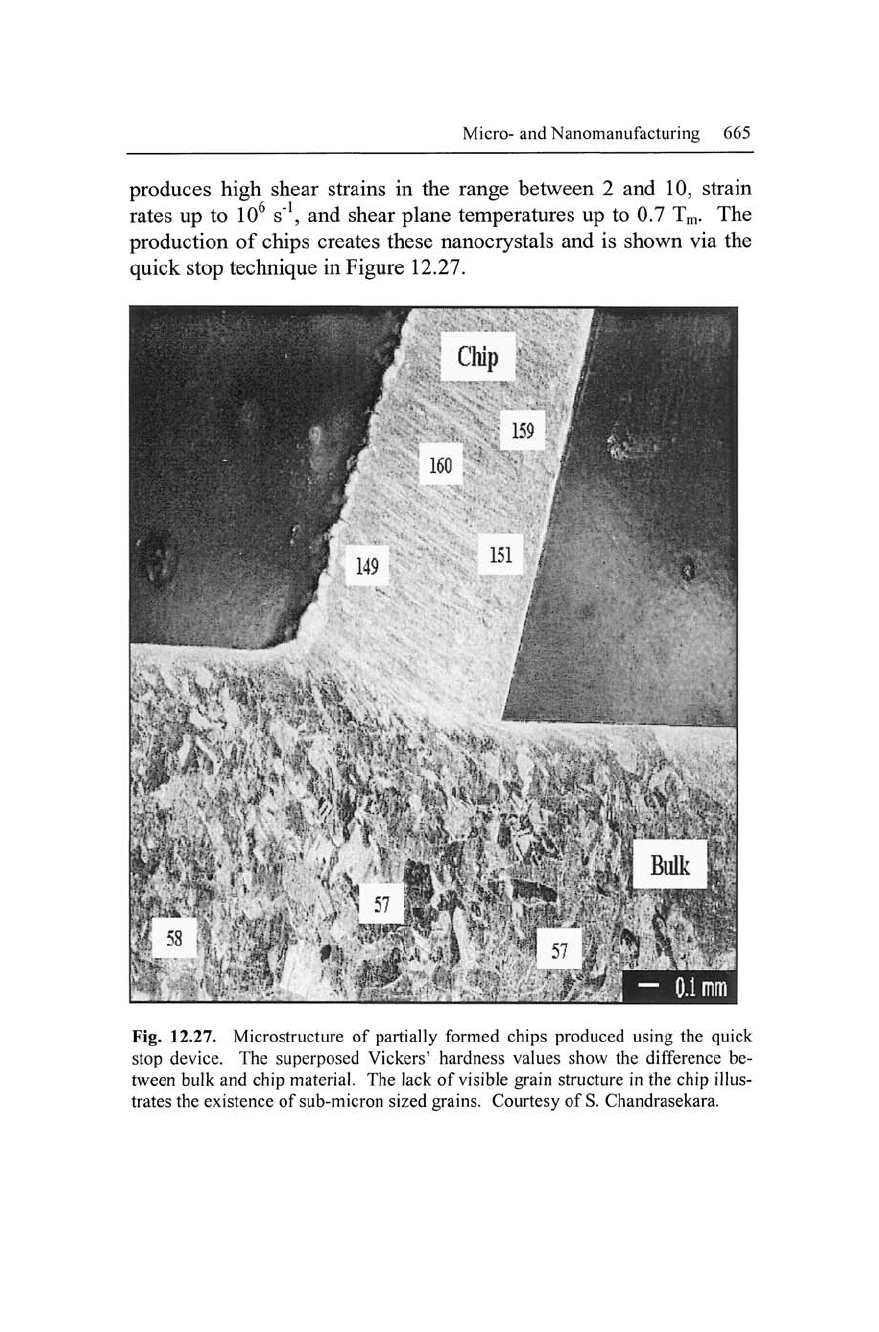
Micro- and Nanomanufacturing 665
produces high shear strains in the range between 2 and 10, strain
rates up to 10^ s"\ and shear plane temperatures up to 0.7 Tm- The
production of chips creates these nanocrystals and is shown via the
quick stop technique in Figure 12.27.
.v'4
••^r ^#5^:;.
-.i^v
•'\'i?J^'^:'^"-''A
—
0.1
mm
Fig. 12.27. Microstructure of partially formed chips produced using the quick
stop device. The superposed Vickers' hardness values show the difference be-
tween bulk and chip material. The lack of visible grain structure in the chip illus-
trates the existence of sub-micron sized grains. Courtesy of
S.
Chandrasekara.
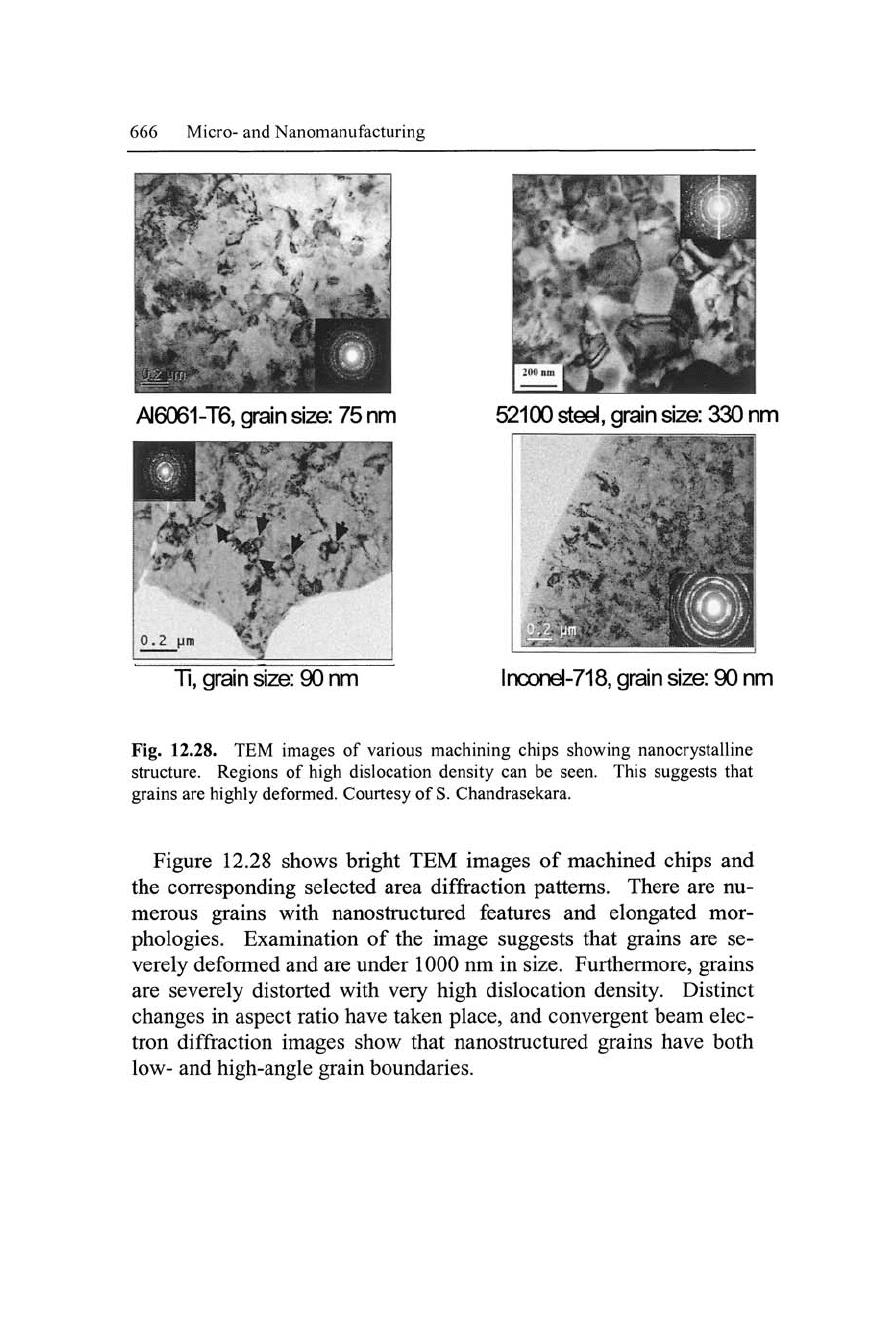
666 Micro- and Nanomanufacturing
AI6061-T6, grain
size:
75 nm
'• • iv.
0.2 M"! %^*
"ft*'''
"
52100
steel,
grain
size:
330 nm
•Si
Wt!l;Ji;.ih"l
Ti,
grain
size:
90 nnn
lncx)nel-718, grain
size:
90 nm
Fig. 12.28. TEM images of various machining chips showing nanocrystalline
structure. Regions of high dislocation density can be seen. This suggests that
grains are highly deformed. Courtesy of
S.
Chandrasekara.
Figure 12.28 shows bright TEM images of machined chips and
the corresponding selected area diffraction patterns. There are nu-
merous grains with nanostructured features and elongated mor-
phologies. Examination of the image suggests that grains are se-
verely deformed and are under 1000 nm in size. Furthermore, grains
are severely distorted with very high dislocation density. Distinct
changes in aspect ratio have taken place, and convergent beam elec-
tron diffraction images show that nanostructured grains have both
low- and high-angle grain boundaries.
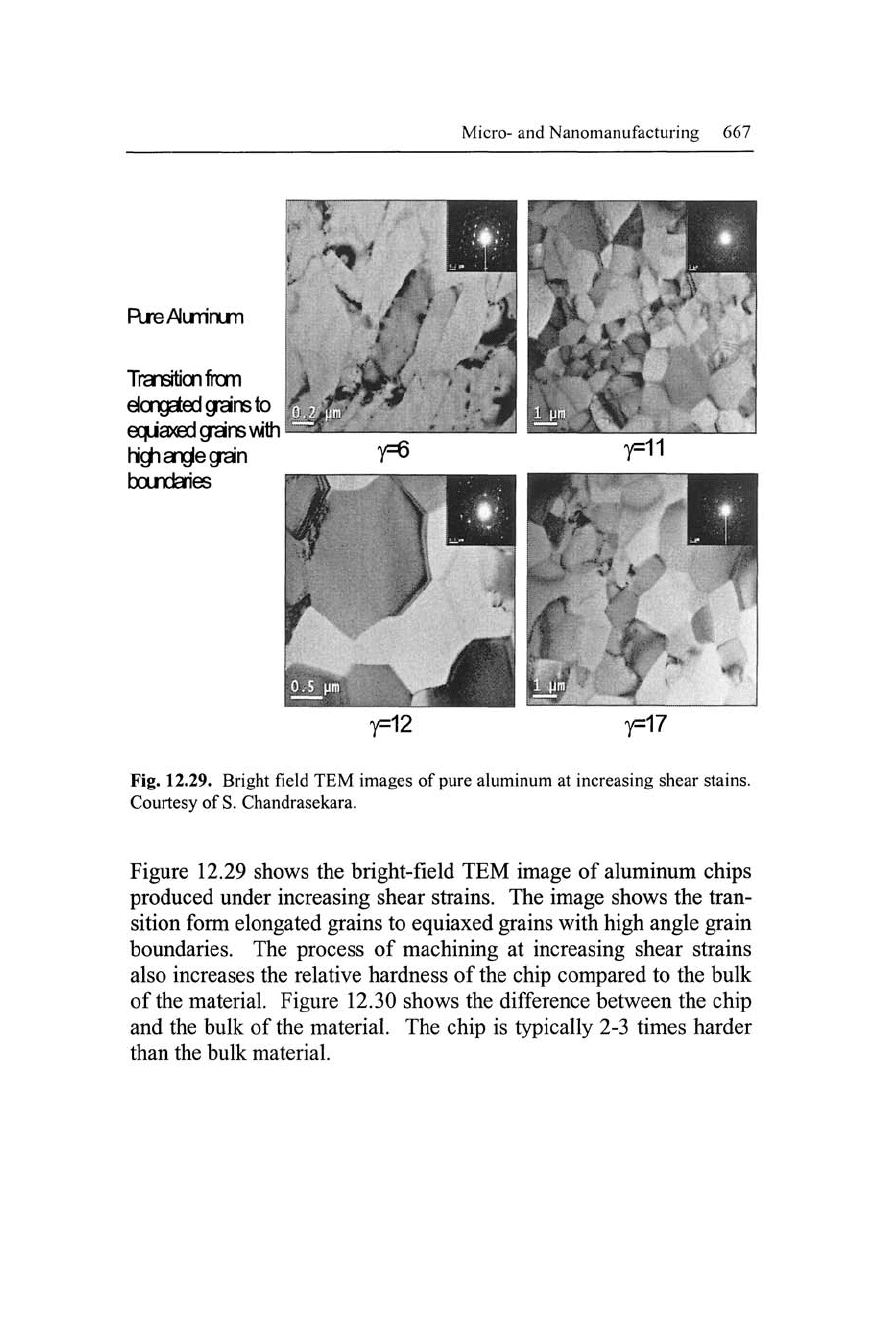
Micro- and Nanomanufacturing 667
Rjre/^uninum
Transition
km
elongeted grans
to
ec|uaxiBdgans\A/ith
N^an^e
grain
boundaries
•t '
BH
^^
Fig. 12.29. Bright field TEM images of pure aluminum at increasing shear stains.
Courtesy of
S.
Chandrasekara.
Figure 12.29 shows the bright-field TEM image of aluminum chips
produced under increasing shear strains. The image shows the tran-
sition form elongated grains to equiaxed grains with high angle grain
boundaries. The process of machining at increasing shear strains
also increases the relative hardness of the chip compared to the bulk
of the material. Figure 12.30 shows the difference between the chip
and the bulk of the material. The chip is typically 2-3 times harder
than the bulk material.
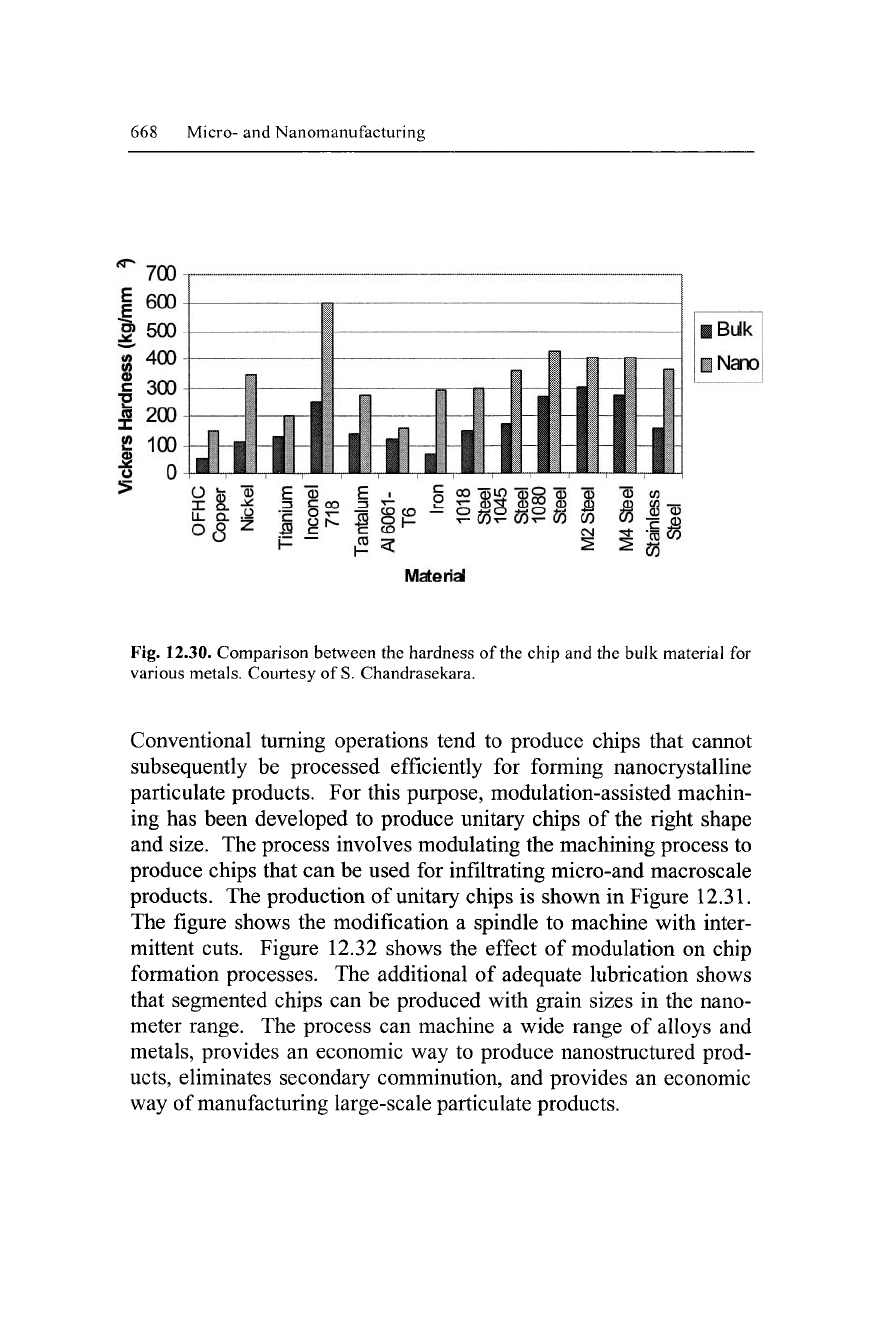
668 Micro- and Nanomanufacturing
iL.
a.
08
E 0)
•i
§?5
£ ^
^ S CD
^ CD "^
0 CO
5
-CD
^
Material
Fig. 12.30. Comparison between the hardness of the chip and the bulk material for
various metals. Courtesy of
S.
Chandrasekara.
Conventional turning operations tend to produce chips that cannot
subsequently be processed efficiently for forming nanocrystalline
particulate products. For this purpose, modulation-assisted machin-
ing has been developed to produce unitary chips of the right shape
and size. The process involves modulating the machining process to
produce chips that can be used for infiltrating micro-and macroscale
products. The production of unitary chips is shown in Figure
12.31.
The figure shows the modification a spindle to machine with inter-
mittent cuts. Figure 12.32 shows the effect of modulation on chip
formation processes. The additional of adequate lubrication shows
that segmented chips can be produced with grain sizes in the nano-
meter range. The process can machine a wide range of alloys and
metals, provides an economic way to produce nanostructured prod-
ucts,
eliminates secondary comminution, and provides an economic
way of manufacturing large-scale particulate products.
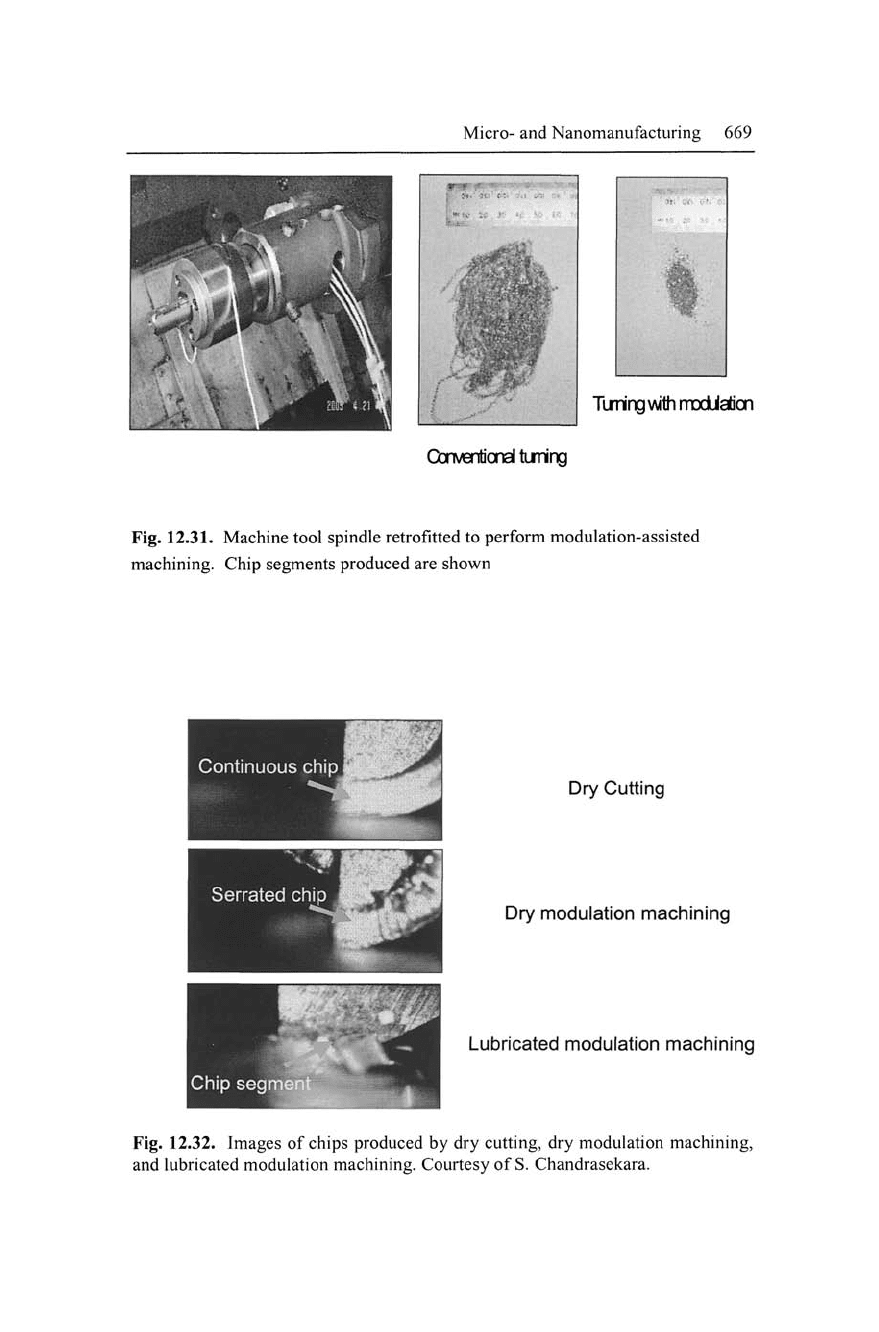
Micro- and Nanomanufacturing
669
Tuning
with
mxUation
Oonventicrial turning
Fig.
12.31.
Machine tool spindle retrofitted
to
perform modulation-assisted
machining. Chip segments produced are shown
Dry Cutting
Dry modulation maciiining
Lubricated modulation machining
Fig. 12.32. Images
of
chips produced
by dry
cutting,
dry
modulation machining,
and lubricated modulation machining. Courtesy
of
S.
Chandrasekara.
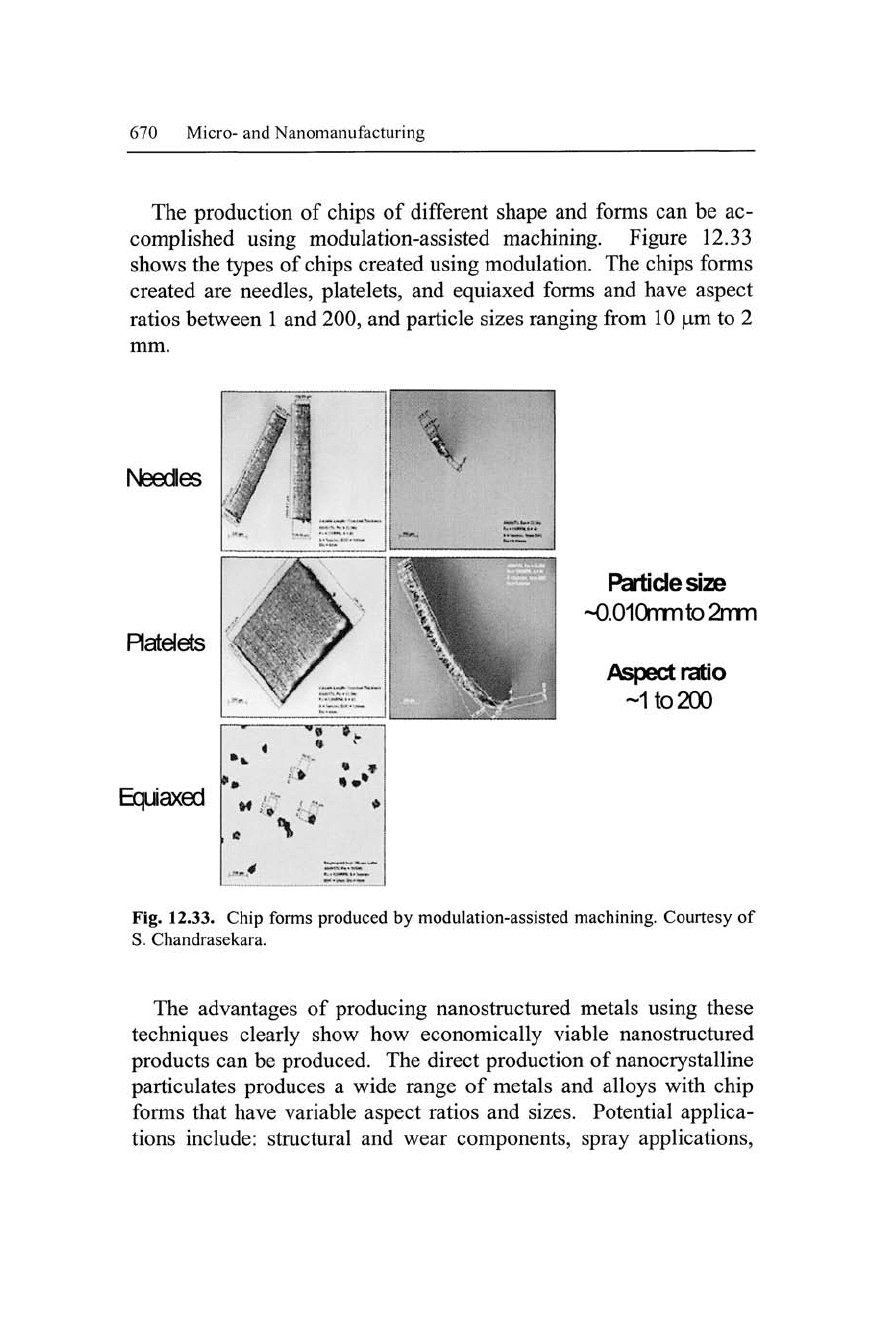
670 Micro- and Nanomanufacturing
The production of chips of different shape and forms can be ac-
complished using modulation-assisted machining. Figure 12.33
shows the types of chips created using modulation. The chips forms
created are needles, platelets, and equiaxed forms and have aspect
ratios between
1
and 200, and particle sizes ranging from 10 |Lim to 2
mm.
Needles
Ratel^
Particle size
-0.010nnmto2nnm
Aspect ratio
H to 200
Bquiaxed
Fig.
12.33.
Chip forms produced by modulation-assisted machining. Courtesy of
S. Chandrasekara.
The advantages of producing nanostructured metals using these
techniques clearly show how economically viable nanostructured
products can be produced. The direct production of nanocrystalline
particulates produces a wide range of metals and alloys with chip
forms that have variable aspect ratios and sizes. Potential applica-
tions include: structural and wear components, spray applications,
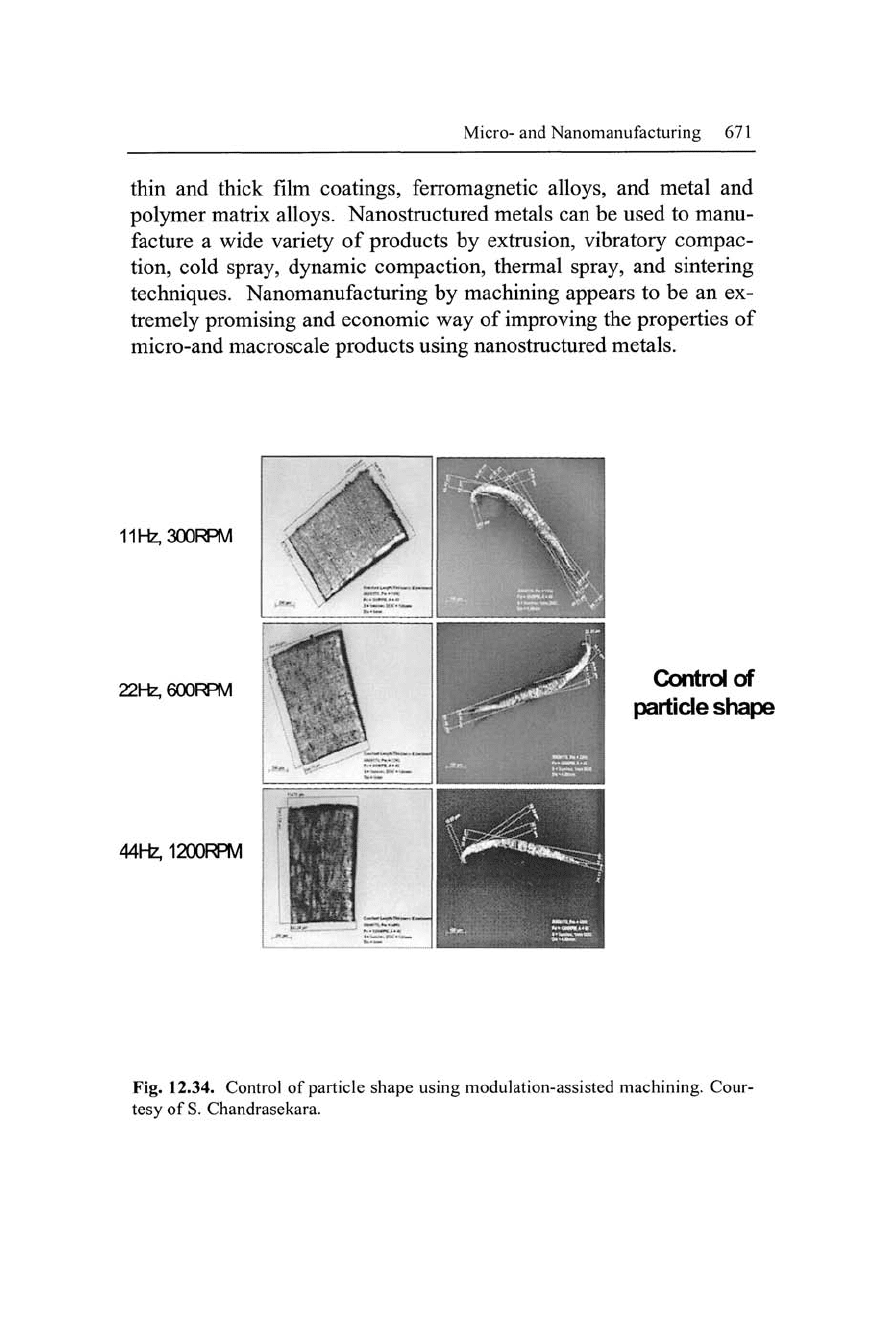
Micro- and Nanomanufacturing 671
thin and thick film coatings, ferromagnetic alloys, and metal and
polymer matrix alloys. Nanostructured metals can be used to manu-
facture a wide variety of products by extrusion, vibratory compac-
tion, cold spray, dynamic compaction, thermal spray, and sintering
techniques. Nanomanufacturing by machining appears to be an ex-
tremely promising and economic way of improving the properties of
micro-and macroscale products using nanostructured metals.
11Hz,300RPM
22Hz,600RPM
44Hz,1200RPM
Control of
particle shape
Fig. 12.34. Control of particle shape using modulation-assisted machining. Cour-
tesy of
S.
Chandrasekara.
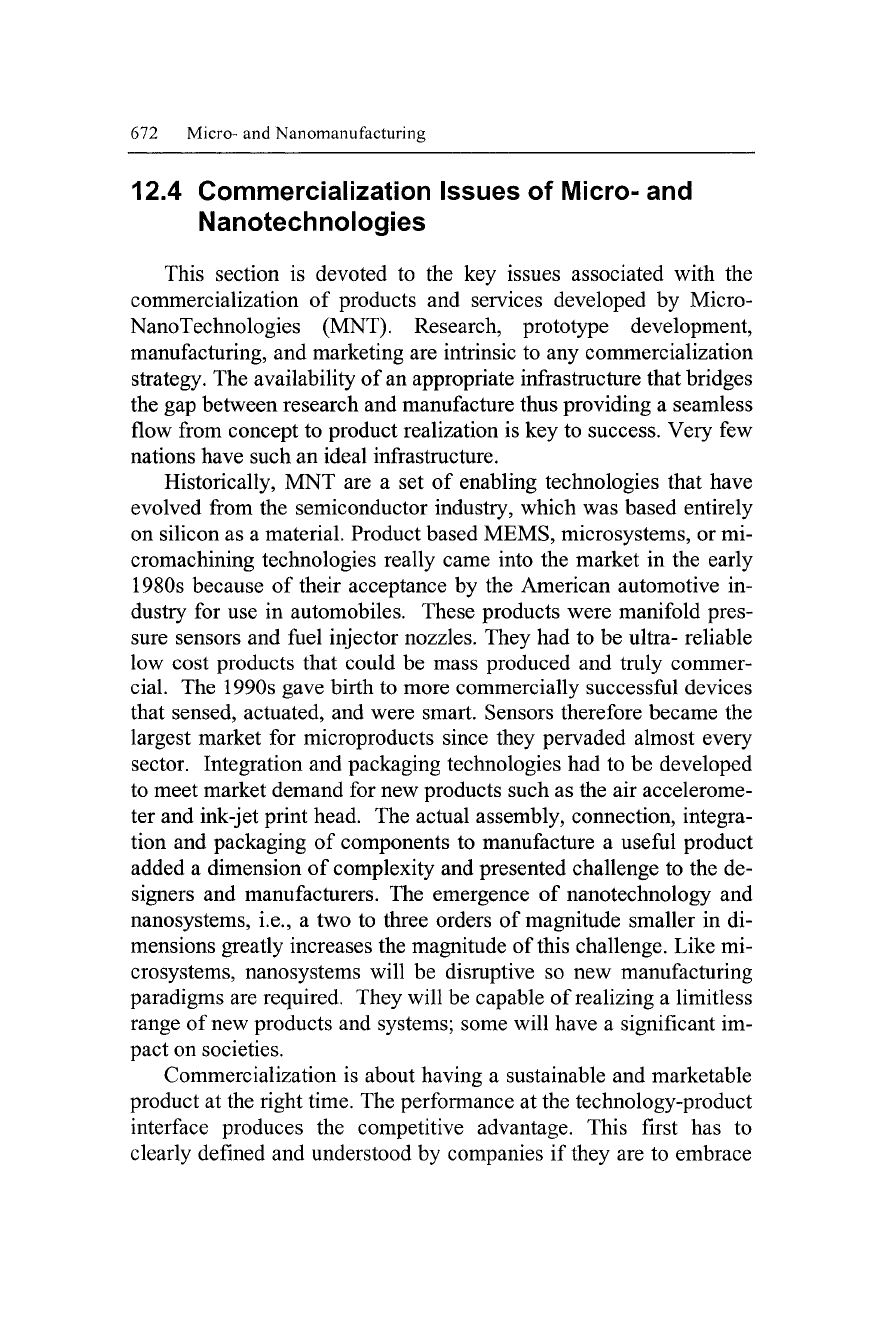
672 Micro- and Nanomanufacturing
12.4 Commercialization Issues of Micro- and
Nanotechnologies
This section is devoted to the key issues associated with the
commerciahzation of products and services developed by Micro-
NanoTechnologies (MNT). Research, prototype development,
manufacturing, and marketing are intrinsic to any commercialization
strategy. The availability of an appropriate infrastructure that bridges
the gap between research and manufacture thus providing a seamless
flow from concept to product realization is key to success. Very few
nations have such an ideal infrastructure.
Historically, MNT are a set of enabling technologies that have
evolved from the semiconductor industry, which was based entirely
on silicon as a material. Product based MEMS, microsystems, or mi-
cromachining technologies really came into the market in the early
1980s because of their acceptance by the American automotive in-
dustry for use in automobiles. These products were manifold pres-
sure sensors and fuel injector nozzles. They had to be ultra- reliable
low cost products that could be mass produced and truly commer-
cial. The 1990s gave birth to more commercially successful devices
that sensed, actuated, and were smart. Sensors therefore became the
largest market for microproducts since they pervaded almost every
sector. Integration and packaging technologies had to be developed
to meet market demand for new products such as the air accelerome-
ter and ink-jet print head. The actual assembly, connection, integra-
tion and packaging of components to manufacture a useful product
added a dimension of complexity and presented challenge to the de-
signers and manufacturers. The emergence of nanotechnology and
nanosystems, i.e., a two to three orders of magnitude smaller in di-
mensions greatly increases the magnitude of this challenge. Like mi-
crosystems, nanosystems will be disruptive so new manufacturing
paradigms are required. They will be capable of realizing a limitless
range of new products and systems; some will have a significant im-
pact on societies.
Commercialization is about having a sustainable and marketable
product at the right time. The performance at the technology-product
interface produces the competitive advantage. This first has to
clearly defined and understood by companies if they are to embrace
